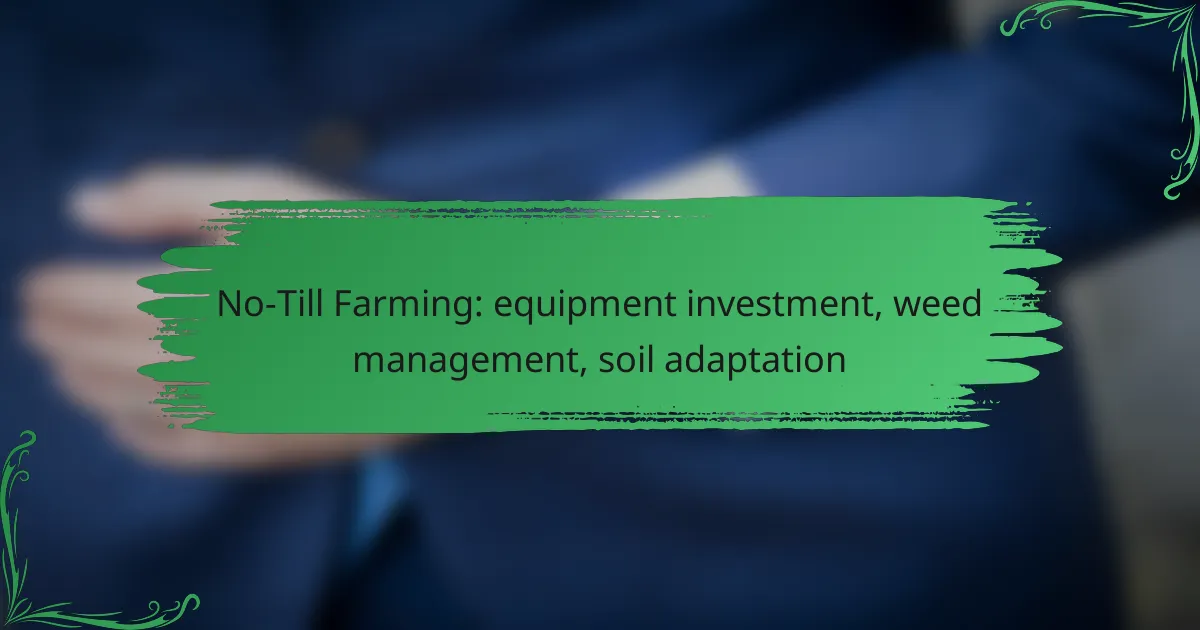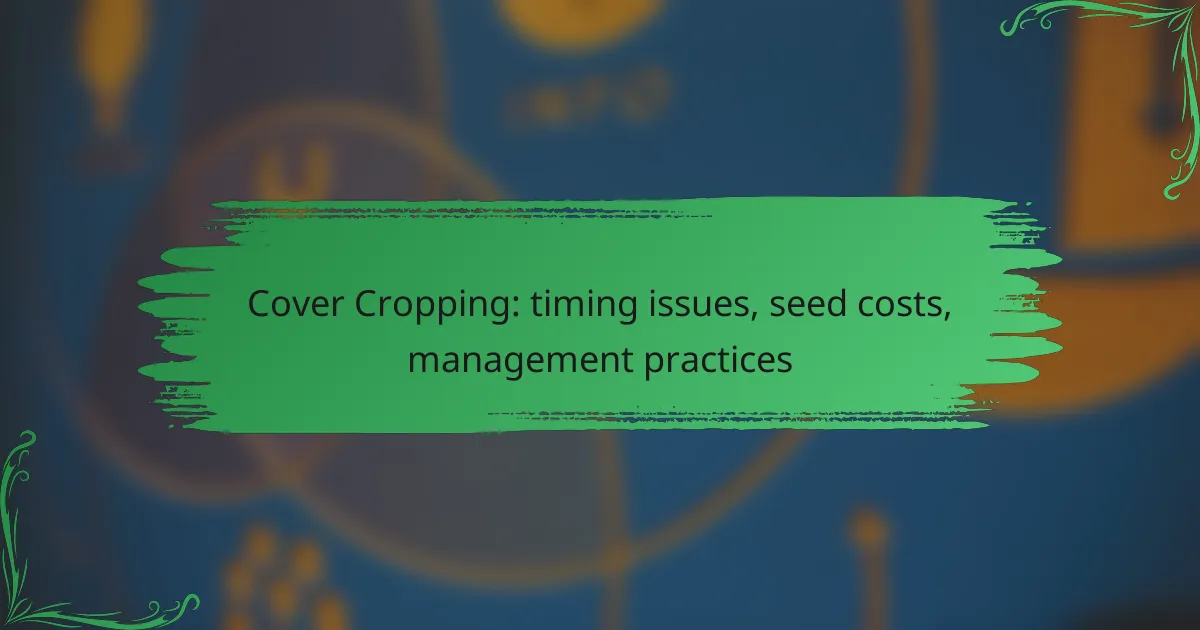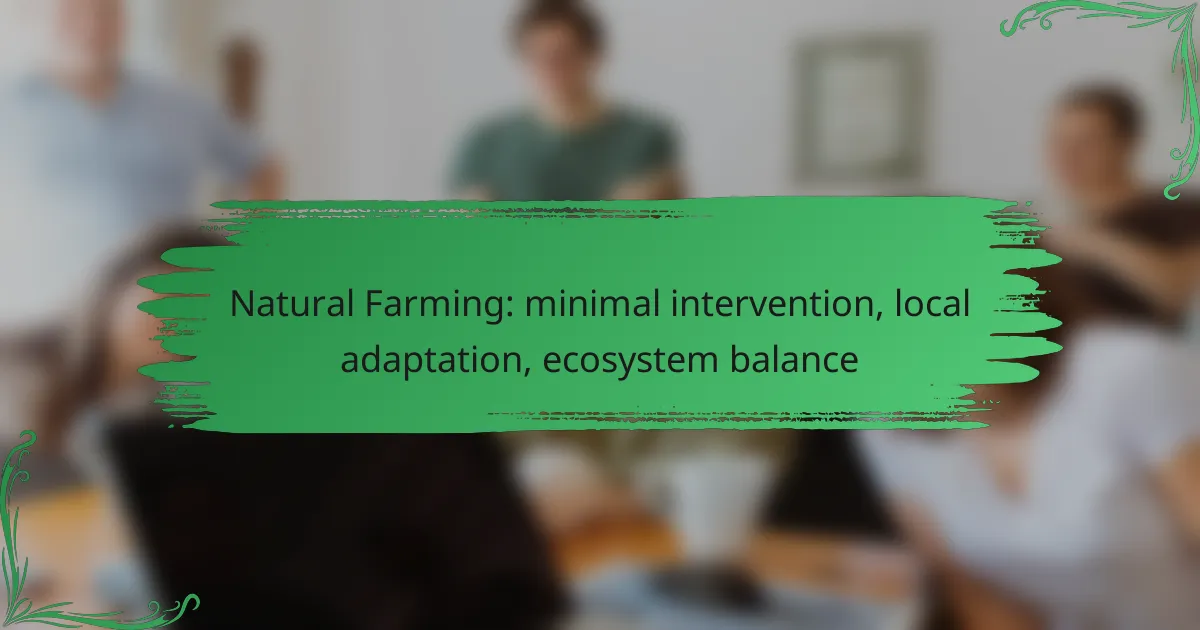No-till farming is an innovative agricultural practice that emphasizes minimal soil disturbance to enhance crop production and soil health. This method requires specialized equipment for planting and weed management, while also employing techniques to improve soil structure and moisture retention. By integrating cover crops and efficient weed control strategies, no-till farming promotes sustainability and boosts yields.

What equipment is essential for no-till farming?
No-till farming requires specific equipment designed to minimize soil disturbance while effectively planting and managing crops. Key tools include seed drills, strip-till machines, cover crop rollers, soil moisture sensors, and weed control equipment, each serving a unique purpose in the no-till process.
Seed drills
Seed drills are crucial for no-till farming as they allow for precise planting without disturbing the soil structure. These machines create narrow furrows in the soil where seeds can be placed directly into the ground, promoting better seed-to-soil contact and reducing erosion.
When selecting a seed drill, consider the type of crops you plan to grow and the soil conditions on your farm. Many seed drills have adjustable settings to accommodate different seed sizes and planting depths, which can enhance germination rates.
Strip-till machines
Strip-till machines prepare the soil in narrow strips while leaving the rest of the field undisturbed. This method combines the benefits of tillage and no-till by allowing for better seedbed preparation and nutrient placement directly in the planting zone.
Investing in a strip-till machine can be advantageous for farmers looking to improve soil health while still managing weeds and nutrients effectively. These machines often feature adjustable widths, making them versatile for various crop types.
Cover crop rollers
Cover crop rollers are used to flatten cover crops before planting, creating a mulch layer that suppresses weeds and retains soil moisture. This equipment helps in managing cover crops effectively, ensuring they provide maximum benefits without interfering with the planting process.
Using a cover crop roller can enhance soil structure and organic matter over time. It’s essential to choose a roller that matches the type of cover crops you are using, as different crops may require different roller designs for optimal results.
Soil moisture sensors
Soil moisture sensors are vital for monitoring moisture levels in no-till systems, helping farmers make informed irrigation decisions. These sensors provide real-time data, allowing for precise water management, which is crucial for crop health and yield.
Investing in quality soil moisture sensors can lead to significant water savings and improved crop performance. Look for sensors that are compatible with your existing farm management systems for seamless integration.
Weed control equipment
Effective weed control is essential in no-till farming, and specialized equipment can help manage weed populations without disturbing the soil. Tools such as high-residue cultivators and flame weeders can be employed to target weeds while preserving the soil structure.
Consider using a combination of mechanical and chemical weed control methods to achieve the best results. Regular monitoring and timely interventions can prevent weeds from becoming a significant issue in your no-till fields.
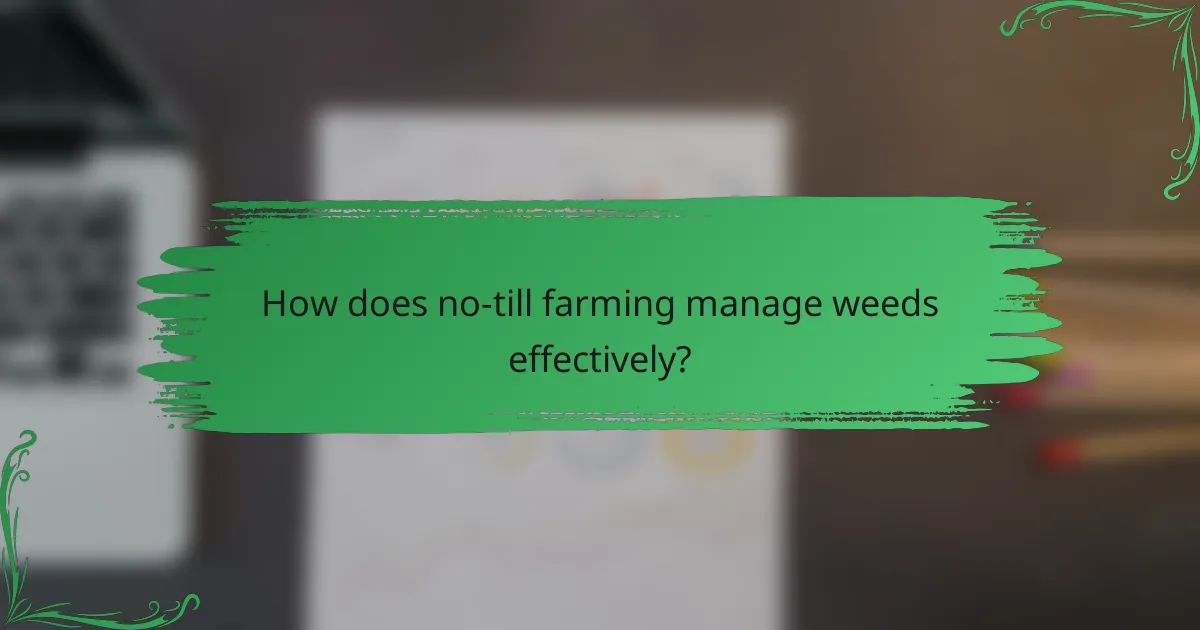
How does no-till farming manage weeds effectively?
No-till farming manages weeds by minimizing soil disturbance, which helps maintain soil structure and moisture while promoting beneficial organisms. This method relies on a combination of cover crops, herbicides, and mechanical techniques to suppress weed growth and enhance crop yields.
Cover crops for weed suppression
Cover crops are planted during off-seasons to suppress weeds by outcompeting them for resources. Common choices include clover, rye, and vetch, which can grow quickly and create a dense canopy. This reduces sunlight and space available for weed seeds to germinate.
In addition to weed suppression, cover crops improve soil health by enhancing organic matter and promoting biodiversity. Farmers should select cover crops based on local climate and soil conditions to maximize their effectiveness.
Herbicide application strategies
Effective herbicide application is crucial in no-till farming to manage weed populations. Farmers should consider using pre-emergent herbicides, which prevent weed seeds from germinating, and post-emergent options that target existing weeds. Timing and application rates are essential for maximizing efficacy.
Integrating herbicides with other weed management practices can reduce reliance on chemicals and help prevent herbicide resistance. Regular monitoring of weed populations can inform adjustments to herbicide strategies, ensuring optimal results.
Mechanical weeding techniques
Mechanical weeding techniques, such as using specialized tools like tine weeders or flame weeders, can effectively manage weeds without disturbing the soil. These methods can be particularly useful in organic no-till systems where chemical options are limited.
Farmers should consider the timing and method of mechanical weeding to avoid damaging crops. Combining mechanical techniques with other strategies can enhance overall weed management and improve crop health.
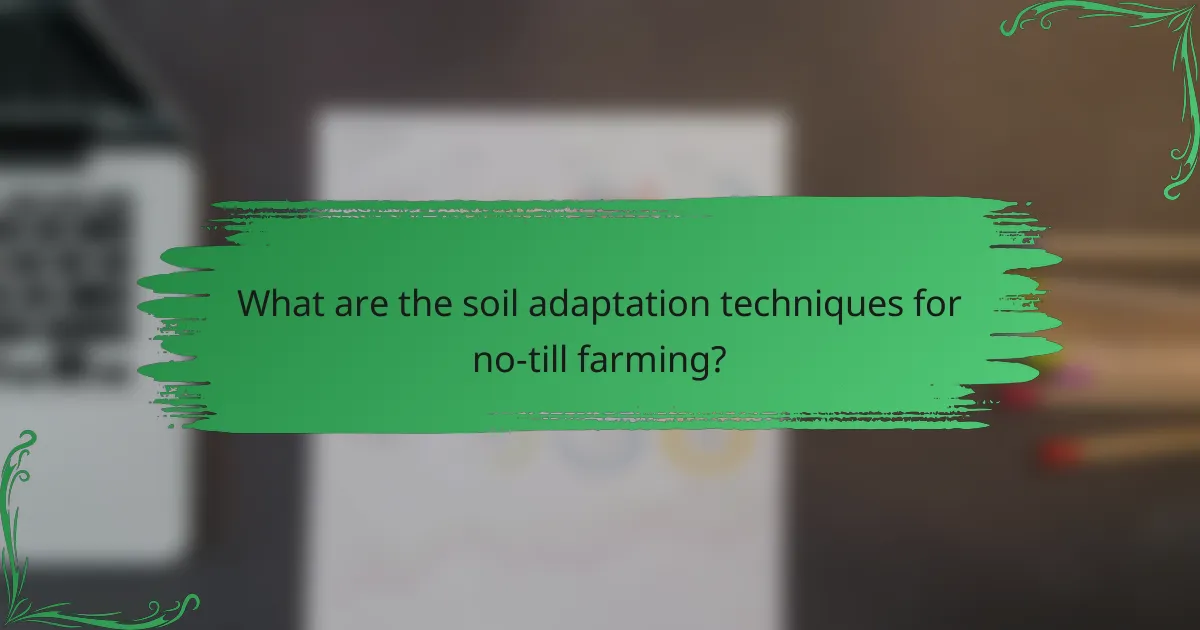
What are the soil adaptation techniques for no-till farming?
Soil adaptation techniques for no-till farming focus on improving soil structure and health while minimizing disturbance. These methods enhance nutrient availability and moisture retention, which are crucial for sustainable crop production.
Soil health monitoring
Regular soil health monitoring is essential for no-till farming as it helps assess nutrient levels, pH, and microbial activity. Farmers should conduct soil tests at least once a year to identify deficiencies and adjust their management practices accordingly.
Utilizing tools like soil moisture sensors can provide real-time data, allowing for timely irrigation and fertilization decisions. This proactive approach can prevent issues such as nutrient leaching and soil compaction.
Crop rotation practices
Implementing diverse crop rotation practices is vital for maintaining soil health in no-till systems. Rotating crops can break pest and disease cycles, improve soil structure, and enhance nutrient cycling.
For instance, alternating between legumes and cereals can increase nitrogen availability and reduce the need for synthetic fertilizers. Aim for a rotation plan that includes at least three different crop types over multiple seasons to maximize benefits.
Organic matter enhancement
Enhancing organic matter in the soil is a key technique for no-till farming, as it improves soil fertility and structure. Incorporating cover crops and applying compost or manure can significantly boost organic content.
Farmers should aim for organic matter levels of at least 3-5% for optimal soil health. Regularly adding organic amendments can help achieve this target while also improving water retention and microbial activity.
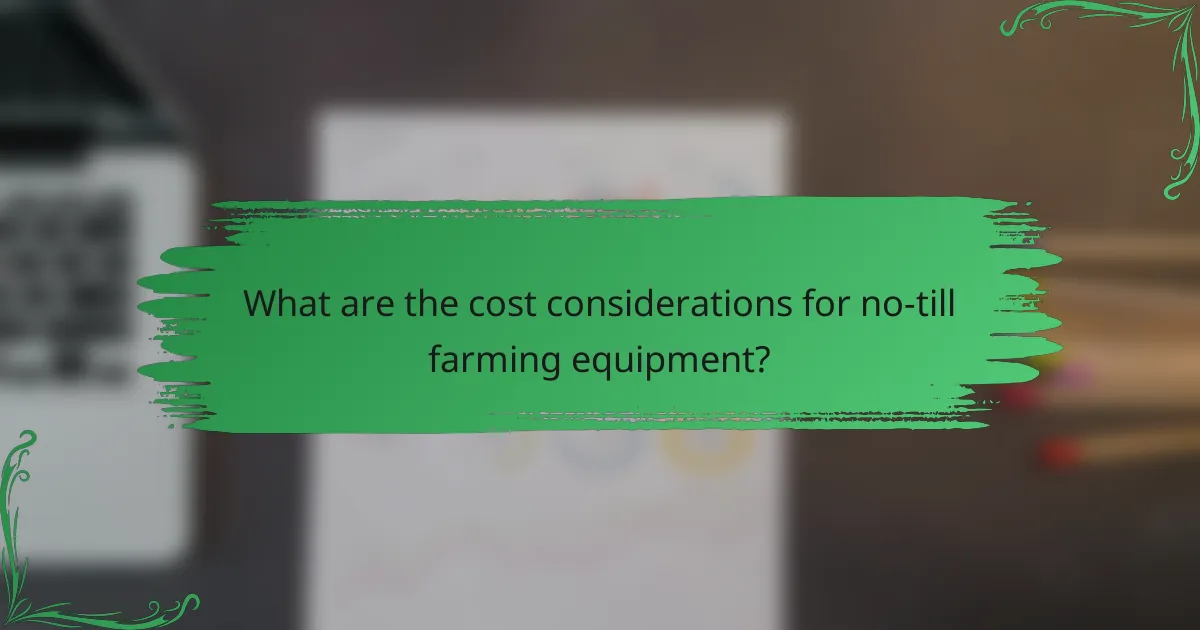
What are the cost considerations for no-till farming equipment?
No-till farming equipment involves various cost considerations that can significantly impact a farmer’s budget. Initial investments, long-term savings, and financing options are crucial factors to evaluate when transitioning to no-till practices.
Initial investment analysis
The initial investment for no-till farming equipment can vary widely based on the type of machinery and technology chosen. Farmers may need to invest in specialized seeders, planters, and cover crop implements, which can range from several thousand to tens of thousands of dollars. It’s essential to assess the specific needs of your operation and the potential return on investment.
Additionally, consider the costs associated with retrofitting existing equipment for no-till practices. This can be a cost-effective option, allowing farmers to adapt their current machinery rather than purchasing entirely new equipment.
Long-term savings on inputs
One of the significant advantages of no-till farming is the potential for long-term savings on inputs such as fertilizers, herbicides, and fuel. By improving soil health and structure, no-till practices can reduce the need for chemical inputs, leading to lower operational costs over time. Farmers often report savings of 20-30% on these inputs compared to conventional tillage methods.
Moreover, no-till farming can enhance moisture retention in the soil, decreasing irrigation costs. This is particularly beneficial in regions where water resources are limited or expensive.
Financing options for farmers
Farmers looking to invest in no-till equipment have several financing options available. Traditional loans from banks or credit unions are common, but there are also specialized agricultural financing programs that may offer lower interest rates or favorable terms. It’s advisable to shop around and compare offers to find the best fit for your financial situation.
Additionally, some government programs and grants may support farmers transitioning to sustainable practices, including no-till farming. Researching local agricultural extension services or government websites can provide valuable information on available financial assistance.

What are the prerequisites for adopting no-till farming?
Adopting no-till farming requires specific equipment, a solid understanding of weed management, and an ability to adapt soil practices. Farmers must be prepared to invest in specialized machinery and develop strategies for effective weed control while ensuring soil health and structure are maintained.
Equipment investment
No-till farming necessitates specific equipment designed to minimize soil disturbance. Essential tools include no-till drills, which allow for planting seeds directly into undisturbed soil, and specialized planters that can handle residue from previous crops. Investing in quality machinery can range from a few thousand to tens of thousands of dollars, depending on the scale of the operation.
Farmers should also consider maintenance costs and the potential need for training to operate new machinery effectively. It’s crucial to evaluate the return on investment by analyzing yield improvements and cost savings from reduced tillage.
Weed management
Effective weed management is critical in no-till farming since the absence of soil disturbance can lead to increased weed pressure. Farmers often rely on cover crops, crop rotation, and targeted herbicide applications to manage weeds. Implementing a diverse cropping system can help suppress weed growth and improve soil health.
Regular monitoring and timely interventions are essential. Farmers should develop a weed management plan that includes identifying weed species, assessing their life cycles, and determining the most effective control measures.
Soil adaptation
Soil adaptation is vital for successful no-till farming, as it requires a shift in how soil health is managed. Farmers must focus on building organic matter and improving soil structure to enhance water retention and nutrient availability. Practices such as adding compost or manure can significantly benefit soil quality over time.
Testing soil regularly helps in understanding nutrient levels and pH, allowing for tailored amendments. Adapting to no-till may take several seasons, so patience and consistent management are key to achieving long-term benefits.
